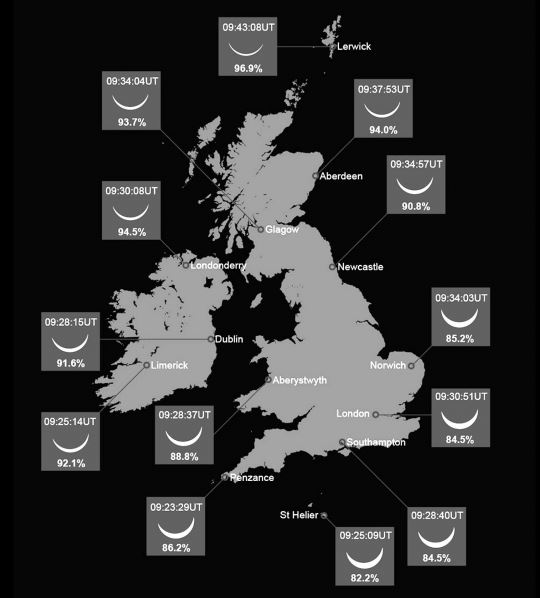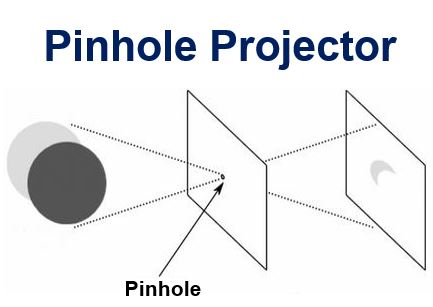For the first time since August 1999, a total eclipse of the Sun will be visible in Northern Europe between Iceland and the Outer Hebrides on March 20th, 2015, says the British Astronomical Association (BAA).
People in the rest of the UK will be able to enjoy partial eclipses, i.e. it will get darker but there won’t be a total blackout.
A total eclipse occurs when the Earth, the Moon and the Sun are exactly lined up, so that the Moon blocks the sunlight and casts a shadow on the surface of the Earth.
According to the BAA, across the UK there will be between 85% obscuration in the south-east of England to more than 97% in the north and north-west of Scotland. The whole event will last more than two hours.

Partial eclipse showing time of maximum obscuration for selected parts of the UK. (Image: British Astronomical Association)
The BAA wrote in its website:
“Indeed, an obvious partial eclipse will be visible from every country in Europe and the partial phase will also be seen from places as widely spread as Newfoundland, North Africa and north-western Asia.”
This will be the last partial solar eclipse of this magnitude over the British Isles until 12 August 2026.
Don’t look directly at the Sun
Remember that looking directly at the Sun is dangerous at any time, even during an eclipse – there is a serious risk of eye damage and even blindness.
To view the Sun safely, you need to make sure its rays are blocked out by special filters.
In its Solar Eclispe Safety Code webpage, the BAA writes:
“DON’T view the Sun through sunglasses of any type (single or multiple pairs), or filters made of black & white or colour photographic film, or any combination of photographic filters, crossed polarisers or gelatin filters, CDs, CD-ROMs, or smoked glass. These are NOT safe.”
“DO view the Sun ONLY through special filters made for safe solar viewing, e.g. aluminised mylar filters, or black polymer filters, identified as suitable for direct viewing of the Sun, bearing the CE mark AND a statement that it conforms to European Community Directive 89/686/EEC, or use a welder’s glass rated at No. 14 or higher. Always read and follow the manufacturer’s instructions carefully.”
When viewing a solar eclipse, make sure children are supervised at all times.
A pinhole projector for a solar eclipse
A safe way of viewing the Sun – uneclipsed and eclipsed – is to project its image on a screen using a pinhole projector or pinhole camera.
You will need:
– two sheets of plain white paper, such as those used in your printer (or two pieces of stiff white paper or white cardboard.
– a sharp pin or thumbtack.
Make a very small hole in the middle of the white sheet of paper using a thumbtack or pin, making sure the hole is smooth and round.

When using the pinhole projector, make sure your back is towards the Sun. Don’t look at the Sun through the pinhole. (Image: British Astronomical Association)
Hold this piece of paper in front of the Sun (don’t look directly at the Sun).
Use the second sheet of paper as a screen, holding it at a distance so that an inverted image of the Sun is projected through the pinhole onto it.
You can change the size of the image by moving the screen nearer or further away from the pinhole.
BBC Video – Solar Eclipse in Varanasi
Discover more from Market Business News
Subscribe to get the latest posts sent to your email.

